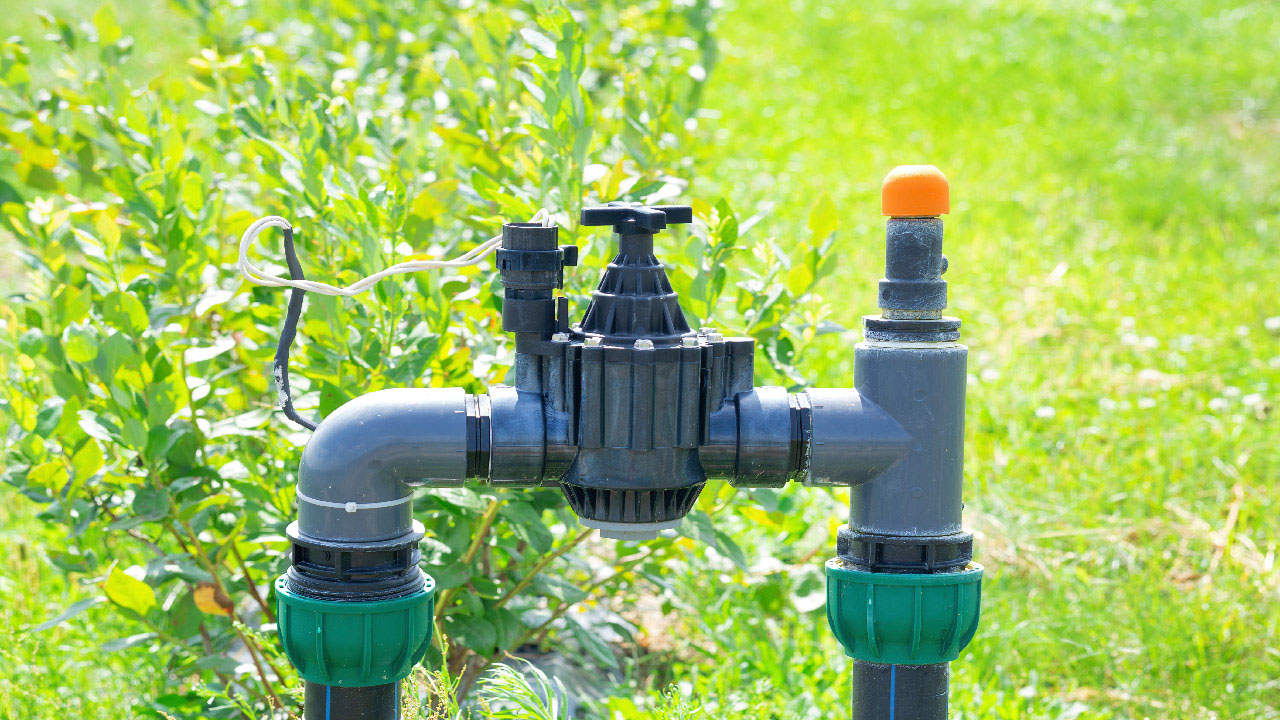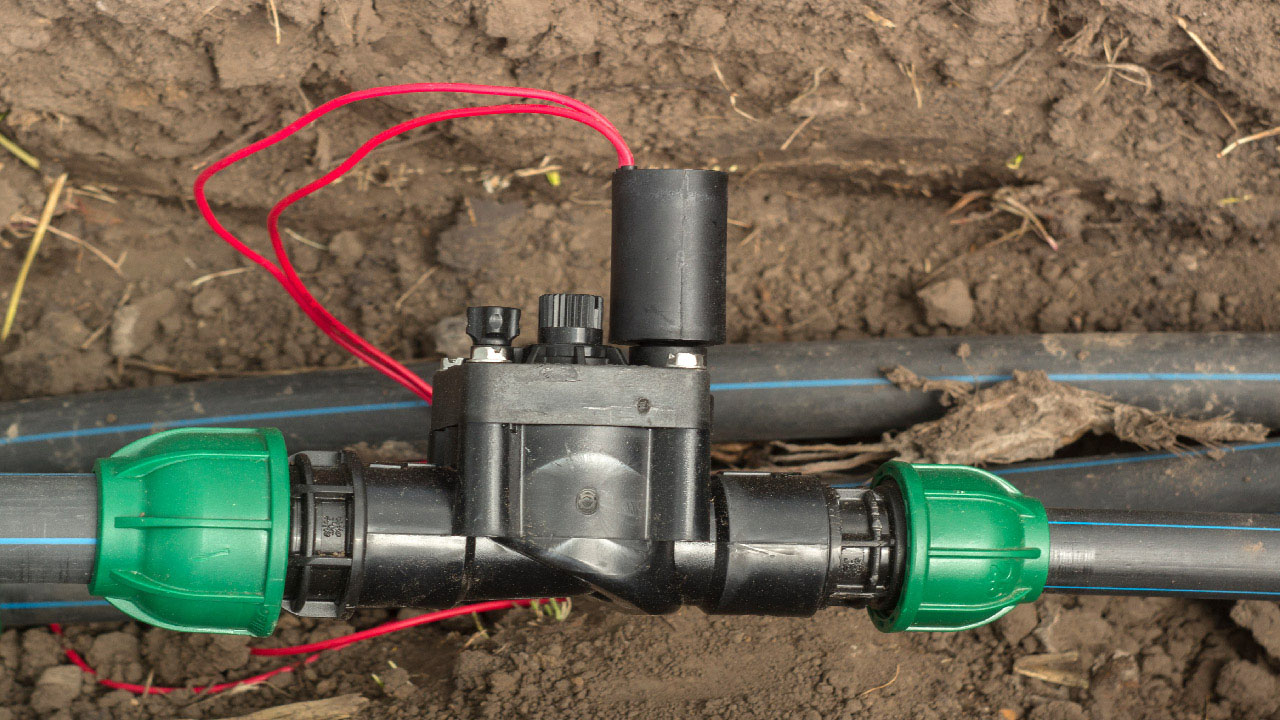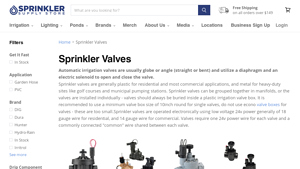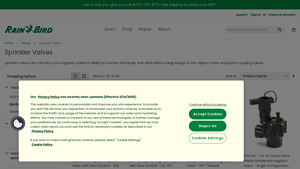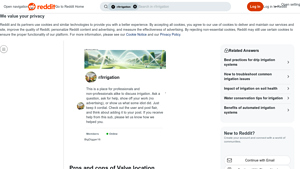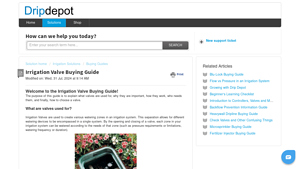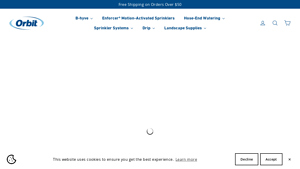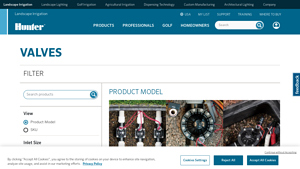Introduction: Navigating the Global Market for valves irrigation system
In an increasingly competitive agricultural landscape, international B2B buyers face the critical challenge of sourcing reliable valves for irrigation systems that meet diverse regional requirements. The efficacy of irrigation systems hinges on the selection of appropriate valves, which not only regulate water flow but also ensure efficient resource management. This guide offers a comprehensive exploration of the global market for valve irrigation systems, covering essential aspects such as types of valves, applications across various sectors, supplier vetting processes, and cost considerations.
By delving into the nuances of valve technology, from automatic sprinkler valves to specialized anti-siphon designs, this guide empowers buyers to make informed purchasing decisions. It highlights key factors to consider when evaluating suppliers, including product quality, compliance with international standards, and after-sales support. Additionally, it provides insights into pricing trends and market dynamics, enabling buyers from Africa, South America, the Middle East, and Europe—including countries like Brazil and Vietnam—to navigate the complexities of sourcing effectively.
Ultimately, this resource serves as a strategic tool for B2B buyers looking to optimize their irrigation systems, enhance agricultural productivity, and secure sustainable water management solutions. With a clear understanding of the market landscape, buyers can confidently engage with suppliers and select the best valve solutions for their unique needs.
Understanding valves irrigation system Types and Variations
| Type Name | Key Distinguishing Features | Primary B2B Applications | Brief Pros & Cons for Buyers |
|---|---|---|---|
| Anti-Siphon Valves | Prevents backflow with built-in air vent; typically plastic | Residential and light commercial | Pros: Prevents contamination; easy installation. Cons: Less durable than metal options. |
| Inline Valves | Installed directly in the pipeline; can be angled or straight | Commercial and industrial irrigation | Pros: Space-saving; versatile design. Cons: May require more complex installation. |
| Globe Valves | Spherical body shape; offers fine flow control | Golf courses, parks, and municipalities | Pros: Excellent flow regulation; durable. Cons: Higher initial cost; larger footprint. |
| Angle Valves | Bent design allows for easier installation in tight spaces | Agricultural applications | Pros: Efficient flow direction; space-efficient. Cons: Limited flow control compared to globe valves. |
| Brass Valves | Made of brass for enhanced durability and corrosion resistance | Heavy-duty commercial and industrial | Pros: Long lifespan; withstands high pressure. Cons: Heavier and more expensive than plastic. |
What are Anti-Siphon Valves and Their Applications in B2B Irrigation Systems?
Anti-siphon valves are designed to prevent backflow into the irrigation system, thus safeguarding water quality. These valves typically feature a built-in air vent that allows air to enter the system when the water pressure drops, preventing siphoning. They are primarily used in residential and light commercial applications. When considering purchasing anti-siphon valves, B2B buyers should evaluate the installation requirements and the valve’s material, as plastic options may offer easier installation but less durability compared to metal alternatives.
How Do Inline Valves Enhance Efficiency in Irrigation Systems?
Inline valves are installed directly within the irrigation pipeline, allowing for a streamlined design that saves space. They can be configured in straight or angled orientations, making them adaptable to various layouts. Commonly used in commercial and industrial irrigation systems, inline valves facilitate efficient water distribution. B2B buyers should consider the complexity of installation and maintenance, as these valves may require additional fittings and adjustments compared to simpler designs.
What Makes Globe Valves Ideal for High-Precision Applications?
Globe valves are characterized by their spherical shape, which allows for precise flow control. They are particularly suited for applications requiring careful regulation of water flow, such as in golf courses, parks, and municipal irrigation systems. While globe valves offer excellent durability and control, they typically come with a higher initial cost and require more space for installation. Buyers should weigh these factors against their specific irrigation needs and budget constraints.
Why Choose Angle Valves for Space-Constrained Installations?
Angle valves feature a bent design that makes them ideal for installations where space is limited. They efficiently direct water flow while maintaining effective operation. These valves are often used in agricultural applications where flexibility and space are critical. B2B buyers should consider the balance between space efficiency and flow control when selecting angle valves, as they may not provide the same level of regulation as globe valves.
What Are the Advantages of Brass Valves in Heavy-Duty Applications?
Brass valves are renowned for their durability and resistance to corrosion, making them an excellent choice for heavy-duty commercial and industrial irrigation systems. They can withstand high pressure and have a long lifespan, which justifies their higher cost. However, their weight and price may deter some buyers. When purchasing brass valves, B2B buyers should assess the specific pressure requirements and environmental conditions of their irrigation projects to ensure optimal performance.
Key Industrial Applications of valves irrigation system
| Industry/Sector | Specific Application of valves irrigation system | Value/Benefit for the Business | Key Sourcing Considerations for this Application |
|---|---|---|---|
| Agriculture | Automated irrigation systems for crop management | Increased crop yield and reduced water wastage | Durability, compatibility with local water sources, and energy efficiency |
| Landscape Maintenance | Sprinkler systems for public parks and gardens | Enhanced aesthetics and reduced labor costs | Quality of materials, ease of maintenance, and adaptability to local climates |
| Golf Course Management | Irrigation control for fairways and greens | Optimized turf health and playability | Precision control features, resistance to corrosion, and reliability |
| Industrial Horticulture | Greenhouse irrigation systems | Improved plant growth and resource management | Customization for plant types, energy consumption, and automation capabilities |
| Municipal Water Management | Water supply control for urban landscaping | Efficient resource allocation and environmental sustainability | Compliance with regulations, scalability, and integration with existing systems |
How Are Valves Irrigation Systems Used in Agriculture?
In the agriculture sector, valves irrigation systems are pivotal for managing water distribution across vast fields. Automated systems equipped with solenoid valves allow farmers to schedule irrigation, ensuring optimal moisture levels for crops. This technology mitigates issues like overwatering and water scarcity, which are prevalent in regions such as Africa and South America. Buyers should prioritize durable materials that withstand local conditions and ensure compatibility with existing irrigation infrastructure.
What Role Do Valves Play in Landscape Maintenance?
Landscape maintenance firms utilize valves irrigation systems to create efficient sprinkler setups for public parks and private gardens. These systems enhance the aesthetic appeal of landscapes while minimizing labor costs associated with manual watering. B2B buyers in this sector must consider the quality of materials to withstand outdoor elements and the ease of maintenance, especially in varying climates across Europe and the Middle East.
How Do Golf Courses Benefit from Irrigation Control?
Golf course management relies heavily on precise irrigation control to maintain turf quality on fairways and greens. Valves irrigation systems help in regulating water flow, which is crucial for maintaining the health and playability of the course. Buyers in this industry should seek valves that offer precision control features and resistance to corrosion, ensuring long-term reliability under diverse environmental conditions.
In What Ways Are Valves Used in Industrial Horticulture?
In industrial horticulture, valves irrigation systems are essential for greenhouse operations, where controlled watering can significantly enhance plant growth. Automated systems allow for the efficient use of water and nutrients, leading to better resource management. Buyers should focus on customization options that cater to specific plant types and energy-efficient solutions that align with sustainability goals.
How Do Municipal Water Management Systems Utilize Irrigation Valves?
Municipal water management entities implement valves irrigation systems to regulate water supply for urban landscaping projects. These systems promote efficient resource allocation and contribute to environmental sustainability by reducing wastage. B2B buyers must consider compliance with local regulations, scalability for future needs, and the ability to integrate with existing water management systems for optimal performance.
3 Common User Pain Points for ‘valves irrigation system’ & Their Solutions
Scenario 1: Difficulty in Sourcing High-Quality Valves for Diverse Applications
The Problem: B2B buyers often struggle to find high-quality valves that meet the specific needs of their irrigation projects. This can be particularly challenging in regions like Africa and South America, where local suppliers may not offer a wide variety of options. As a result, buyers may resort to purchasing inferior products that do not withstand the rigors of different climates, leading to frequent replacements and increased costs.
The Solution: To overcome this challenge, buyers should prioritize sourcing valves from reputable manufacturers known for their durability and performance. Conducting thorough market research to identify suppliers with a proven track record is essential. Buyers should also consider valves designed specifically for the local environment—such as those made from corrosion-resistant materials for humid climates or heavy-duty metal valves for areas with extreme temperatures. It’s advisable to request samples or conduct field tests before making bulk purchases. Establishing relationships with manufacturers who offer extensive warranties can also provide peace of mind, ensuring that any defects or performance issues are addressed promptly.
Scenario 2: Complications with Installation and Maintenance of Irrigation Valves
The Problem: The installation and maintenance of irrigation valves can present significant challenges for B2B buyers, especially those managing large agricultural operations or municipal irrigation systems. Incorrect installation can lead to leaks, inconsistent water pressure, and system failures, which can severely impact crop yields or water conservation efforts. Furthermore, the complexity of maintaining these systems often results in increased downtime and labor costs.
The Solution: To address these complications, buyers should invest in comprehensive training for their staff or subcontractors involved in the installation and maintenance processes. Partnering with experienced irrigation consultants can also streamline this process. Additionally, choosing valves that are designed for easy installation—such as quick-coupling valves or those with user-friendly features—can significantly reduce installation time and errors. Buyers should also implement a regular maintenance schedule that includes routine inspections and timely replacement of worn components. Utilizing digital tools or software for monitoring valve performance can help detect issues early, minimizing downtime and costly repairs.
Scenario 3: Navigating Regulatory Compliance and Water Management Standards
The Problem: In regions like the Middle East and Europe, strict regulations regarding water usage and irrigation practices can complicate the purchasing process for valves. B2B buyers may face challenges ensuring that their selected products comply with local laws and standards, which can vary significantly between countries. Non-compliance not only results in legal penalties but can also damage a company’s reputation and hinder future business opportunities.
The Solution: Buyers should familiarize themselves with local regulations and standards related to irrigation systems before making purchases. Collaborating with local industry associations or regulatory bodies can provide valuable insights and updates on compliance requirements. When sourcing valves, buyers should specifically inquire about certifications and compliance documentation from suppliers. It’s also beneficial to opt for valves from manufacturers who are known to prioritize environmental sustainability and adhere to international standards. This approach not only ensures compliance but also positions the buyer as a responsible and forward-thinking entity in the market. Regularly reviewing and updating compliance knowledge as regulations evolve will further safeguard against potential issues.
Strategic Material Selection Guide for valves irrigation system
What Are the Key Properties of Common Materials Used in Valves for Irrigation Systems?
When selecting materials for valves in irrigation systems, it’s crucial to consider their properties, as these directly influence performance, durability, and cost. Below are analyses of four common materials used in the manufacturing of irrigation valves: PVC, brass, stainless steel, and polyethylene.
PVC (Polyvinyl Chloride)
Key Properties: PVC valves are lightweight and resistant to corrosion, making them suitable for various irrigation applications. They typically handle pressures up to 150 psi and can operate effectively within a temperature range of -40°F to 140°F.
Pros & Cons: The primary advantages of PVC include its low cost and ease of installation due to its lightweight nature. However, PVC can become brittle over time, especially when exposed to UV light, and may not withstand high-pressure applications as effectively as metal alternatives.
Impact on Application: PVC is compatible with a wide range of water types, including potable water. However, its limitations in high-temperature applications may restrict its use in certain climates.
Considerations for International Buyers: Buyers should ensure compliance with local standards such as ASTM for North America or DIN for Europe. In regions with high UV exposure, additional protective measures may be necessary.
Brass
Key Properties: Brass valves are known for their excellent corrosion resistance and durability, withstanding pressures up to 300 psi and temperatures ranging from -40°F to 180°F.
Pros & Cons: The main advantages of brass include its strength and longevity, making it ideal for high-pressure systems. However, brass is more expensive than PVC and can be susceptible to dezincification, which may limit its use in certain water conditions.
Impact on Application: Brass valves are highly suitable for applications involving potable water and are often preferred in commercial settings due to their reliability.
Considerations for International Buyers: Compliance with standards such as JIS in Japan or EN in Europe is essential. Buyers should also consider the availability of brass in their region, as supply chains may vary.
Stainless Steel
Key Properties: Stainless steel valves are robust, with pressure ratings often exceeding 600 psi and temperature ratings up to 400°F. They are highly resistant to corrosion, making them suitable for harsh environments.
Pros & Cons: The primary advantage of stainless steel is its exceptional durability and resistance to corrosion, which makes it ideal for long-term applications. However, the high cost and complexity of manufacturing stainless steel valves can be a disadvantage for budget-conscious buyers.
Impact on Application: Stainless steel is compatible with a wide range of fluids, including aggressive chemicals, making it suitable for diverse irrigation applications.
Considerations for International Buyers: Buyers should be aware of the specific grades of stainless steel that comply with local standards. In regions with stringent environmental regulations, such as Europe, the use of stainless steel may be favored.
Polyethylene
Key Properties: Polyethylene valves are flexible and lightweight, with pressure ratings typically up to 100 psi and a temperature range of -40°F to 140°F. They are resistant to corrosion and UV light.
Pros & Cons: The advantages of polyethylene include its low cost and ease of installation. However, its lower pressure rating compared to metal valves may limit its use in high-pressure systems.
Impact on Application: Polyethylene is suitable for non-potable water applications and is often used in agricultural irrigation systems.
Considerations for International Buyers: Compliance with local standards is crucial, especially in regions where the quality of irrigation water is regulated. Buyers should also consider the availability of polyethylene fittings and valves in their local markets.
Summary Table of Material Selection for Valves in Irrigation Systems
| Material | Typical Use Case for valves irrigation system | Key Advantage | Key Disadvantage/Limitation | Relative Cost (Low/Med/High) |
|---|---|---|---|---|
| PVC | Residential and light commercial irrigation | Low cost and lightweight | Brittle over time, UV sensitivity | Low |
| Brass | Commercial and high-pressure systems | Excellent durability and corrosion resistance | Higher cost, dezincification risk | Med |
| Stainless Steel | Industrial and harsh environment applications | Exceptional durability and corrosion resistance | High cost and manufacturing complexity | High |
| Polyethylene | Agricultural irrigation systems | Low cost and easy installation | Lower pressure rating compared to metals | Low |
This strategic material selection guide aims to equip international B2B buyers with essential insights into the materials used for valves in irrigation systems, facilitating informed purchasing decisions that align with their specific needs and regional standards.
In-depth Look: Manufacturing Processes and Quality Assurance for valves irrigation system
What Are the Main Stages of Manufacturing Valves for Irrigation Systems?
The manufacturing process of irrigation valves is intricate and involves several key stages to ensure high-quality products.
Material Preparation: The process begins with selecting suitable materials, which can range from high-density plastics for residential applications to robust metals for heavy-duty commercial uses. Suppliers typically source materials that meet industry standards, ensuring they possess the necessary durability and resistance to environmental factors.
Forming: Once the materials are prepared, they undergo various forming techniques. For plastic valves, processes like injection molding are common, allowing for precise shapes and efficient mass production. Metal components may be formed through machining or casting, depending on the design requirements. This stage is crucial as it determines the valve’s structural integrity and functionality.
Assembly: After forming, the individual components are assembled. This includes integrating essential parts such as diaphragms, solenoids, and seals. Automated assembly lines are often employed to enhance efficiency, though some critical components may still be assembled manually to ensure precision and quality.
Finishing: The final stage involves surface finishing, which can include polishing, coating, or painting to enhance aesthetics and protect against corrosion. Quality checks are performed during this phase to ensure that each valve meets the specified tolerances and standards.
How Is Quality Assurance Implemented in the Valve Manufacturing Process?
Quality assurance (QA) is a vital aspect of manufacturing valves for irrigation systems, focusing on maintaining high standards throughout production.
International Standards Compliance: Many manufacturers adhere to international standards such as ISO 9001, which outlines requirements for quality management systems. Compliance with such standards helps ensure consistent product quality and customer satisfaction.
Industry-Specific Certifications: Depending on the market, manufacturers may also pursue industry-specific certifications. For example, CE marking indicates conformity with health, safety, and environmental protection standards within the European Economic Area. Similarly, API (American Petroleum Institute) standards may apply for valves used in oil and gas applications.
Quality Control Checkpoints: Effective QA involves multiple checkpoints throughout the manufacturing process, including:
– Incoming Quality Control (IQC): Inspection of raw materials before production begins to ensure they meet the required specifications.
– In-Process Quality Control (IPQC): Continuous monitoring during the manufacturing process to identify any deviations from quality standards in real-time.
– Final Quality Control (FQC): Comprehensive testing and inspection of finished products before they are shipped to customers.Common Testing Methods: Various testing methods are employed to verify valve performance and reliability. These include pressure testing to check for leaks, flow rate tests to ensure adequate performance, and durability tests that simulate long-term usage conditions.
How Can B2B Buyers Verify Supplier Quality Control Processes?
For international B2B buyers, especially from regions like Africa, South America, the Middle East, and Europe, verifying a supplier’s quality control processes is essential to ensuring product reliability.
Supplier Audits: Conducting regular audits of suppliers allows buyers to assess their manufacturing processes, quality control measures, and compliance with international standards. This could be done through on-site visits or by reviewing audit reports.
Quality Reports: Requesting detailed quality reports can provide insights into the supplier’s quality management practices. These reports often include information on testing results, defect rates, and corrective actions taken in response to identified issues.
Third-Party Inspections: Engaging third-party inspection agencies can help validate the quality of the products before they are shipped. These inspections can cover everything from raw material checks to final product evaluations, providing an unbiased assessment of quality.
Certifications and Documentation: Buyers should always request copies of relevant certifications and documentation that demonstrate compliance with international standards and regulations. This includes ISO certifications, CE marks, and any other industry-specific qualifications that may apply.
What Are the Quality Control Nuances for International B2B Buyers?
Navigating quality control in an international context comes with its own set of challenges and considerations.
Understanding Regional Standards: Different regions may have varying standards and regulations governing product quality. Buyers should familiarize themselves with these standards to ensure that the products they are purchasing will be compliant in their respective markets.
Cultural Considerations: Cultural differences can affect communication and expectations regarding quality. B2B buyers must be clear and precise about their quality requirements and ensure that suppliers fully understand these expectations.
Logistics and Supply Chain Management: The geographical distance between manufacturers and buyers can complicate quality assurance. Implementing robust logistics and supply chain management practices is critical to maintaining product quality during transportation.
Building Long-Term Relationships: Establishing strong, long-term relationships with suppliers can enhance trust and facilitate better communication regarding quality standards. Regular engagement and feedback can help suppliers align their quality control processes with buyers’ expectations.
In conclusion, understanding the manufacturing processes and quality assurance practices for irrigation valves is essential for B2B buyers. By focusing on these areas, buyers can make informed decisions, ensuring they procure reliable, high-quality products that meet their specific needs.
Practical Sourcing Guide: A Step-by-Step Checklist for ‘valves irrigation system’
Introduction
In today’s competitive agricultural landscape, selecting the right valves for your irrigation system is critical for optimizing performance and ensuring water efficiency. This guide provides a practical checklist designed for B2B buyers looking to source valves for irrigation systems, enabling informed decisions that meet operational needs and regional requirements.
Step 1: Define Your Technical Specifications
Establishing clear technical specifications is fundamental to sourcing the right irrigation valves. Consider factors such as valve type (e.g., anti-siphon, inline), size, pressure ratings, and material (plastic vs. metal). Specific requirements can vary significantly based on the intended application—residential, commercial, or industrial.
- Pressure Ratings: Ensure the valves can handle the operational pressure of your system.
- Flow Control Features: Decide if you need valves with integrated flow control to manage water distribution effectively.
Step 2: Research and Shortlist Suppliers
Conduct thorough research to identify potential suppliers that specialize in irrigation valves. Look for companies with a solid reputation in the industry and experience in your target regions, such as Africa, South America, the Middle East, and Europe.
- Supplier Reviews: Check online reviews and testimonials from other B2B buyers to gauge reliability and service quality.
- Product Range: Ensure the supplier offers a diverse selection of valves that align with your specifications.
Step 3: Evaluate Potential Suppliers
Before committing to a supplier, it’s crucial to vet them thoroughly. Request company profiles, product catalogs, and case studies to understand their capabilities and past performance.
- References: Ask for references from other clients, especially those within your industry or region, to validate the supplier’s credibility.
- Certifications: Verify that suppliers have relevant certifications that meet local and international standards.
Step 4: Request Samples for Testing
Before placing a bulk order, request samples of the valves you are considering. Testing these samples in your operational environment will provide insights into their performance and compatibility.
- Field Testing: Evaluate how the valves perform under real-world conditions, including pressure and flow dynamics.
- Durability Assessment: Check for resistance to environmental factors such as UV exposure and corrosion.
Step 5: Negotiate Terms and Conditions
Once you have selected a supplier and tested the products, negotiate the terms of the purchase. Ensure clarity on pricing, delivery timelines, and warranty conditions.
- Volume Discounts: Inquire about bulk order discounts or incentives for long-term contracts.
- After-Sales Support: Understand the level of customer support and maintenance services offered post-purchase.
Step 6: Plan for Logistics and Delivery
Consider the logistics involved in the procurement process. This includes assessing shipping methods, customs requirements, and lead times for delivery.
- Shipping Options: Evaluate different shipping methods based on cost and urgency.
- Customs and Regulations: Familiarize yourself with import regulations and duties that may apply in your country or region.
Step 7: Monitor Installation and Performance
After procurement, closely monitor the installation process and the performance of the valves in your irrigation system. Regular checks and maintenance can help identify any issues early and ensure optimal operation.
- Feedback Loop: Establish a system for ongoing feedback from users to address any concerns related to valve performance.
- Performance Metrics: Track key metrics such as water efficiency and system pressure to assess the effectiveness of the valves.
By following this checklist, B2B buyers can confidently source valves for irrigation systems that meet their operational needs and contribute to sustainable agricultural practices.
Comprehensive Cost and Pricing Analysis for valves irrigation system Sourcing
When sourcing valves for irrigation systems, understanding the comprehensive cost structure and pricing dynamics is crucial for making informed purchasing decisions. This analysis breaks down the essential cost components, price influencers, and provides valuable tips for B2B buyers, particularly those operating in diverse international markets such as Africa, South America, the Middle East, and Europe.
What Are the Key Cost Components in Sourcing Irrigation Valves?
The cost structure for irrigation valves typically encompasses several critical components:
Materials: The choice of materials significantly influences costs. Plastic valves are generally less expensive and suitable for residential applications, while metal valves are preferred for heavy-duty uses like municipal projects. Premium materials may enhance durability but at a higher cost.
Labor: Labor costs vary based on the complexity of the valve design and the manufacturing processes involved. Automated production may lower labor costs, while specialized craftsmanship for custom valves can increase them.
Manufacturing Overhead: Overhead costs include utilities, facility maintenance, and equipment depreciation. Efficient manufacturing processes can help mitigate these expenses.
Tooling: Initial tooling costs can be substantial for custom valve designs. However, these costs are often amortized over large production runs, making them more manageable on a per-unit basis.
Quality Control (QC): Rigorous QC processes ensure product reliability and compliance with industry standards. Investing in quality assurance can prevent costly recalls and enhance brand reputation.
Logistics: Transportation and warehousing costs are critical, especially for international shipments. Factors such as distance, mode of transport, and local regulations can impact overall logistics expenses.
Margin: Suppliers typically add a margin to cover risks and ensure profitability. Understanding the market dynamics can help buyers negotiate better terms.
How Do Price Influencers Affect the Cost of Irrigation Valves?
Several factors can influence the pricing of irrigation valves:
Volume/MOQ: Bulk purchases often lead to significant discounts. Buyers should consider their projected needs and negotiate minimum order quantities (MOQs) to optimize costs.
Specifications and Customization: Custom valves tailored to specific applications can incur additional costs. Buyers must balance the need for customization with budget constraints.
Materials and Quality Certifications: Valves made from high-grade materials or those that meet specific quality certifications (like ISO or NSF) typically command higher prices. Assessing the long-term value of these features is essential.
Supplier Factors: The reputation and reliability of the supplier can affect pricing. Established suppliers may charge more due to their track record of quality and service.
Incoterms: Understanding Incoterms (International Commercial Terms) is vital for managing costs related to shipping and responsibilities. These terms dictate who bears the costs and risks during transportation.
What Are Some Tips for Buyers to Optimize Costs?
B2B buyers can leverage several strategies to ensure cost-efficiency in their valve procurement:
Negotiate Wisely: Always engage in negotiations with suppliers. Leverage bulk purchasing and long-term contracts to secure better pricing.
Consider Total Cost of Ownership (TCO): Evaluate not just the purchase price but also maintenance, operational efficiency, and longevity. A lower upfront cost might lead to higher operational costs over time.
Understand Pricing Nuances for International Sourcing: Be aware of currency fluctuations, import duties, and local taxes that can significantly impact the final cost of valves sourced from overseas.
Research Market Trends: Stay updated on market trends and pricing fluctuations. This knowledge can empower buyers to make timely purchasing decisions and avoid overpaying.
Disclaimer on Pricing
The prices mentioned in various sources are indicative and can vary based on several factors, including market conditions, supplier negotiations, and geographical location. Always seek multiple quotes and conduct thorough due diligence before finalizing any purchase.
Alternatives Analysis: Comparing valves irrigation system With Other Solutions
Introduction: Exploring Alternatives to Valves Irrigation Systems
In the realm of agricultural irrigation, selecting the right system can significantly impact efficiency and productivity. While valves irrigation systems are a popular choice due to their reliability and automation capabilities, various alternatives exist that may better suit specific operational needs. This section will compare valves irrigation systems with two alternative solutions: drip irrigation systems and surface irrigation methods, providing insights into their performance, costs, ease of implementation, maintenance, and best use cases.
Comparison Table
| Comparison Aspect | Valves Irrigation System | Drip Irrigation System | Surface Irrigation Method |
|---|---|---|---|
| Performance | Highly efficient with precise control | Very efficient, minimizes water waste | Variable efficiency, depends on topography |
| Cost | Moderate initial investment, ongoing costs | High upfront costs, low operating costs | Low initial costs, higher water loss |
| Ease of Implementation | Requires technical expertise for setup | Complex installation, specialized knowledge needed | Relatively simple to install |
| Maintenance | Requires regular checks and repairs | Low maintenance but requires filters | Regular maintenance needed to manage soil and water |
| Best Use Case | Large-scale, high-value crops | Small to medium-scale, water-sensitive crops | Large fields with uniform topography |
Detailed Breakdown of Alternatives
Drip Irrigation System:
Drip irrigation systems deliver water directly to the root zone of plants through a network of tubing and emitters. This method is highly efficient, especially in regions where water is scarce. Its ability to minimize evaporation and runoff makes it ideal for water-sensitive crops. However, the initial investment can be high due to the cost of materials and the complexity of installation. Maintenance is generally low, but filters must be regularly checked to prevent clogging. Drip systems are best suited for small to medium-scale farms where precise water management is critical.
Surface Irrigation Method:
Surface irrigation involves distributing water over the soil surface using gravity. This method is often the simplest and most cost-effective way to irrigate large areas. However, its efficiency can be significantly affected by the topography of the land and soil type, leading to uneven water distribution. While the initial setup costs are low, surface irrigation can result in higher water loss through evaporation and runoff, making it less suitable for water-scarce regions. Regular maintenance is needed to manage soil structure and ensure effective water flow. Surface irrigation works best in large, flat fields where uniform water distribution is feasible.
Conclusion: How to Choose the Right Irrigation Solution
When deciding between a valves irrigation system and its alternatives, B2B buyers should carefully assess their specific needs, including crop types, land conditions, and available resources. A valves irrigation system may be ideal for larger operations requiring precise control and automation, while drip irrigation offers superior efficiency for water-sensitive crops. Conversely, surface irrigation can be a cost-effective option for large, flat fields. By evaluating these factors, buyers can make informed decisions that align with their operational goals and environmental considerations.
Essential Technical Properties and Trade Terminology for valves irrigation system
What Are the Key Technical Properties of Valves in Irrigation Systems?
When selecting valves for irrigation systems, understanding the essential technical properties is crucial for ensuring performance, reliability, and compatibility with existing infrastructure. Here are some critical specifications to consider:
Material Grade
The material used in valve construction significantly impacts durability and resistance to environmental factors. Common materials include PVC, which is lightweight and resistant to corrosion, and brass, known for its strength and longevity. Selecting the right material is vital to match the valve’s application, especially in harsh climates typical in regions like Africa and the Middle East.Pressure Rating
This specification indicates the maximum pressure the valve can withstand, typically measured in PSI (pounds per square inch). For irrigation systems, valves should generally have a pressure rating that exceeds the system’s operational pressure to prevent failure. Understanding pressure ratings helps ensure the valve can handle the demands of both residential and commercial applications, particularly in agricultural settings.Flow Control
Flow control refers to the valve’s ability to manage the rate of water flow through the system. Valves equipped with flow control mechanisms allow for precise adjustments, optimizing water usage, which is increasingly important in regions facing water scarcity. This property can significantly affect irrigation efficiency and crop yield.Size and Compatibility
Valves come in various sizes, typically denoted by their diameter (e.g., 1 inch, 2 inches). Ensuring compatibility with existing piping systems is essential for seamless installation and operation. Incorrect sizing can lead to inefficiencies, increased wear, and potential system failures, making it a critical consideration for B2B buyers.Diaphragm Type
The diaphragm in a valve plays a key role in its operation, affecting how the valve opens and closes. Common types include flat and molded diaphragms, each offering different advantages in terms of sealing and flow characteristics. Understanding diaphragm types helps buyers select valves that maintain optimal performance in their specific applications.
What Are Common Trade Terms Used in the Valves Industry?
Navigating the procurement process for irrigation valves requires familiarity with industry-specific terminology. Here are several essential terms:
OEM (Original Equipment Manufacturer)
OEM refers to companies that produce parts or equipment that may be marketed by another manufacturer. In the context of valves, understanding OEM relationships can help buyers identify quality suppliers and components tailored for specific irrigation systems.MOQ (Minimum Order Quantity)
MOQ is the smallest number of units a supplier is willing to sell. This term is crucial for B2B buyers, as understanding MOQ can affect inventory management and cash flow. Suppliers often set MOQs based on production costs and logistics, particularly in regions with varying demand levels.RFQ (Request for Quotation)
An RFQ is a document issued by a buyer to solicit pricing and other details from suppliers. For businesses sourcing valves, issuing an RFQ can help compare prices, terms, and specifications from multiple vendors, ensuring competitive procurement practices.Incoterms (International Commercial Terms)
Incoterms are standardized trade terms that define the responsibilities of buyers and sellers in international transactions. Familiarity with Incoterms is critical for B2B buyers engaged in cross-border procurement, as they clarify who bears risks and costs during shipping, which can impact overall project budgets.Lead Time
Lead time refers to the period between placing an order and receiving the goods. Understanding lead times is essential for effective project planning, especially in regions with long supply chains or where irrigation systems are time-sensitive, such as during planting seasons.
By grasping these technical properties and trade terms, B2B buyers can make informed decisions that enhance the efficiency and reliability of their irrigation systems, ultimately contributing to better agricultural outcomes and resource management.
Navigating Market Dynamics and Sourcing Trends in the valves irrigation system Sector
What Are the Current Market Dynamics and Key Trends in the Valves Irrigation System Sector?
The valves irrigation system sector is witnessing robust growth driven by several global factors. Increasing agricultural demands, particularly in regions like Africa and South America, are prompting investments in efficient irrigation technologies. This demand is further fueled by the necessity for sustainable farming practices and the efficient use of water resources. In the Middle East, where water scarcity is a pressing issue, the adoption of advanced irrigation systems is accelerating. Moreover, European markets are increasingly focused on integrating smart technologies into irrigation systems, creating opportunities for B2B buyers to explore innovative products that enhance efficiency and reduce operational costs.
Emerging technologies are reshaping sourcing trends in this sector. The use of automation and IoT (Internet of Things) in valve systems is becoming prevalent, allowing for remote monitoring and control, which optimizes water usage and reduces waste. B2B buyers should pay attention to suppliers who offer smart valve solutions, as these can significantly enhance productivity. Additionally, the trend towards customization is on the rise, with buyers looking for tailored solutions that meet specific agricultural needs, creating a competitive edge for suppliers who can provide bespoke services.
How Can Sustainability and Ethical Sourcing Impact the Valves Irrigation System Sector?
Sustainability is increasingly at the forefront of purchasing decisions in the valves irrigation system sector. The environmental impact of irrigation practices is under scrutiny, with a growing emphasis on minimizing water waste and energy consumption. Buyers are encouraged to seek out suppliers that demonstrate a commitment to sustainable practices, such as using recyclable materials in valve manufacturing and implementing energy-efficient production processes.
Ethical sourcing is equally critical, as buyers are becoming more conscious of the supply chain’s social implications. Ensuring that suppliers adhere to fair labor practices and environmental regulations not only enhances brand reputation but also aligns with global sustainability goals. Buyers should prioritize suppliers that offer ‘green’ certifications, such as ISO 14001 for environmental management, which signifies responsible production practices. By fostering partnerships with ethically compliant suppliers, B2B buyers can contribute to a more sustainable industry while securing high-quality products for their irrigation systems.
What Is the Brief Evolution and History of the Valves Irrigation System Sector?
The valves irrigation system sector has evolved significantly over the past few decades. Initially dominated by basic mechanical valves, the industry has transitioned towards more sophisticated solutions, incorporating electronic controls and automation. The introduction of materials like PVC and advanced polymers has also transformed valve design, enhancing durability and reducing costs.
In recent years, the focus has shifted toward integrating smart technologies, enabling precision agriculture practices. This evolution reflects the industry’s response to global challenges such as climate change and water scarcity, driving innovation and efficiency. As the sector continues to evolve, international B2B buyers must stay informed about these advancements to leverage the latest technologies and best practices in their operations.
Frequently Asked Questions (FAQs) for B2B Buyers of valves irrigation system
How do I choose the right valve for my irrigation system?
Choosing the right valve for your irrigation system involves assessing the specific needs of your application. Consider factors such as the type of crops, soil conditions, and the overall design of your irrigation layout. For residential and light commercial applications, plastic valves are typically sufficient, while heavy-duty sites may require metal valves. Additionally, evaluate the valve’s flow rate, pressure rating, and compatibility with your existing system to ensure optimal performance.What is the best type of valve for large-scale agricultural irrigation?
For large-scale agricultural irrigation, electric solenoid valves are often the best choice due to their reliability and efficiency. These valves can be automated and controlled remotely, providing precision in water application. Look for valves that offer features such as anti-siphon capabilities to prevent contamination and high-pressure ratings to handle the demands of extensive irrigation systems. Brands like Rain Bird and Hunter are renowned for their durable and high-performance options.What are the key factors to consider when vetting valve suppliers?
When vetting suppliers for irrigation valves, prioritize their experience and reputation in the industry. Check for certifications that demonstrate compliance with international standards. Request references from previous clients and evaluate their customer service responsiveness. Additionally, consider the supplier’s ability to provide technical support and after-sales service, as these are crucial for maintaining your irrigation system’s functionality.What customization options are available for irrigation valves?
Many manufacturers offer customization options for irrigation valves, including size, material, and specific features tailored to your irrigation needs. Common customizations include flow control mechanisms, pressure ratings, and connection types. Discuss your requirements with potential suppliers to explore available modifications. Custom solutions can enhance efficiency and ensure compatibility with your existing system, leading to better water management.What are the typical minimum order quantities (MOQs) for valves?
Minimum order quantities (MOQs) for irrigation valves can vary significantly based on the supplier and the type of valve. Generally, MOQs can range from 10 to 100 units. Some manufacturers may offer lower MOQs for standard products, while custom orders may require larger quantities. It’s essential to discuss MOQs upfront with suppliers to align your purchasing strategy with their production capabilities.What payment terms are common in international B2B transactions for irrigation valves?
In international B2B transactions, payment terms can vary, but common practices include letters of credit, advance payments, or payment on delivery. Many suppliers may request a deposit upfront, typically between 30-50%, with the balance due upon shipment. Always negotiate terms that protect your interests while ensuring the supplier’s security. Establishing clear payment terms upfront can help avoid misunderstandings and foster a successful business relationship.How can I ensure quality assurance (QA) for the valves I purchase?
To ensure quality assurance for your irrigation valves, request product samples before making a bulk purchase. Verify that the supplier adheres to relevant international quality standards, such as ISO certifications. Additionally, consider third-party inspections or audits to assess manufacturing processes. Establishing a clear QA process with your supplier can help mitigate risks and ensure that you receive high-quality products that meet your specifications.What logistics considerations should I keep in mind when importing valves?
When importing valves, consider logistics factors such as shipping methods, lead times, and customs regulations in your country. Choose a reliable freight forwarder who understands the specific requirements for agricultural equipment. Ensure that all necessary documentation, including invoices and certificates of origin, is in order to facilitate smooth customs clearance. Planning for potential delays and understanding the costs associated with shipping can help you manage your supply chain effectively.
Important Disclaimer & Terms of Use
⚠️ Important Disclaimer
The information provided in this guide, including content regarding manufacturers, technical specifications, and market analysis, is for informational and educational purposes only. It does not constitute professional procurement advice, financial advice, or legal advice.
While we have made every effort to ensure the accuracy and timeliness of the information, we are not responsible for any errors, omissions, or outdated information. Market conditions, company details, and technical standards are subject to change.
B2B buyers must conduct their own independent and thorough due diligence before making any purchasing decisions. This includes contacting suppliers directly, verifying certifications, requesting samples, and seeking professional consultation. The risk of relying on any information in this guide is borne solely by the reader.
Top 6 Valves Irrigation System Manufacturers & Suppliers List
1. Sprinkler Supply Store – Automatic Irrigation Valves
Domain: sprinklersupplystore.com
Registered: 2010 (15 years)
Introduction: Sprinkler valves are automatic irrigation valves that can be globe or angle (straight or bent) and use a diaphragm and an electric solenoid to operate. They are typically made of plastic for residential and most commercial applications, while metal valves are used for heavy-duty sites such as golf courses and municipal pumping stations.
2. Rain Bird – Sprinkler Valves
Domain: store.rainbird.com
Registered: 1995 (30 years)
Introduction: This company, Rain Bird – Sprinkler Valves, is a notable entity in the market. For specific product details, it is recommended to visit their website directly.
3. Irrigation Insights – Valve Placement Considerations
Domain: reddit.com
Registered: 2005 (20 years)
Introduction: The discussion revolves around the pros and cons of valve location in irrigation systems, specifically regarding the placement of valves in relation to the pump and sprinkler heads. Key considerations include: 1. Fewer parts and labor are required with a single mainline and valves along it compared to using manifolds. 2. Valves located close to sprinkler heads provide faster response times for ful…
4. Drip Depot – Irrigation Valves
Domain: help.dripdepot.com
Registered: 2005 (20 years)
Introduction: Irrigation valves are used to create various watering zones in an irrigation system, allowing for different watering devices to be encompassed in a single system. They are important for managing water flow and pressure across different zones, ensuring optimal performance of watering devices. Valves can be manual or automatic, with automatic options available in Alternating Current (AC) and Direct …
5. Orbit – Top Underground Valves for Sprinkler and Drip Systems
Domain: orbitonline.com
Registered: 1999 (26 years)
Introduction: Top Underground Valves for Sprinkler and Drip Systems
6. Hunter Irrigation – Key Valve Solutions
Domain: hunterirrigation.com
Registered: 2001 (24 years)
Introduction: {“products”:[{“model”:”1″},{“model”:”1½”},{“model”:”2″},{“model”:”ICV”},{“model”:”IBV”},{“model”:”PGV-ASV”},{“model”:”Accu Sync®”},{“model”:”Quick Couplers”},{“model”:”Wireless Valve Link”},{“model”:”Drip Control Zone Kits”},{“model”:”PGV Jar-Top”}],”inlet_sizes”:[“¾”,”1″,”1¼”,”1½”,”2″,”3″],”features”:[“Smart Technology”,”Remote Control Compatible”],”applications”:[“Inline Irrigation”,”Online Irri…
Strategic Sourcing Conclusion and Outlook for valves irrigation system
How Can Strategic Sourcing Enhance Your Irrigation System Efficiency?
In summary, strategic sourcing is paramount for optimizing your irrigation system’s performance, particularly when it comes to valve selection. Understanding the diverse range of options—from automatic and anti-siphon valves to specialized industrial solutions—empowers international B2B buyers to make informed decisions that enhance irrigation efficiency and reduce operational costs. The ability to source high-quality materials and components from reliable suppliers ensures longevity and reliability in irrigation systems, crucial for agricultural productivity in regions such as Africa, South America, the Middle East, and Europe.
By leveraging data-driven insights and supplier relationships, businesses can significantly enhance their procurement strategies, ensuring they secure the best prices without compromising on quality. As the global market continues to evolve, embracing innovative technologies and sustainable practices will be essential for staying competitive.
Looking ahead, we encourage buyers to actively engage with suppliers and explore the latest advancements in valve technology. This proactive approach will not only facilitate better sourcing decisions but also position your organization at the forefront of the irrigation industry, driving growth and sustainability. Take the next step in your strategic sourcing journey today.

